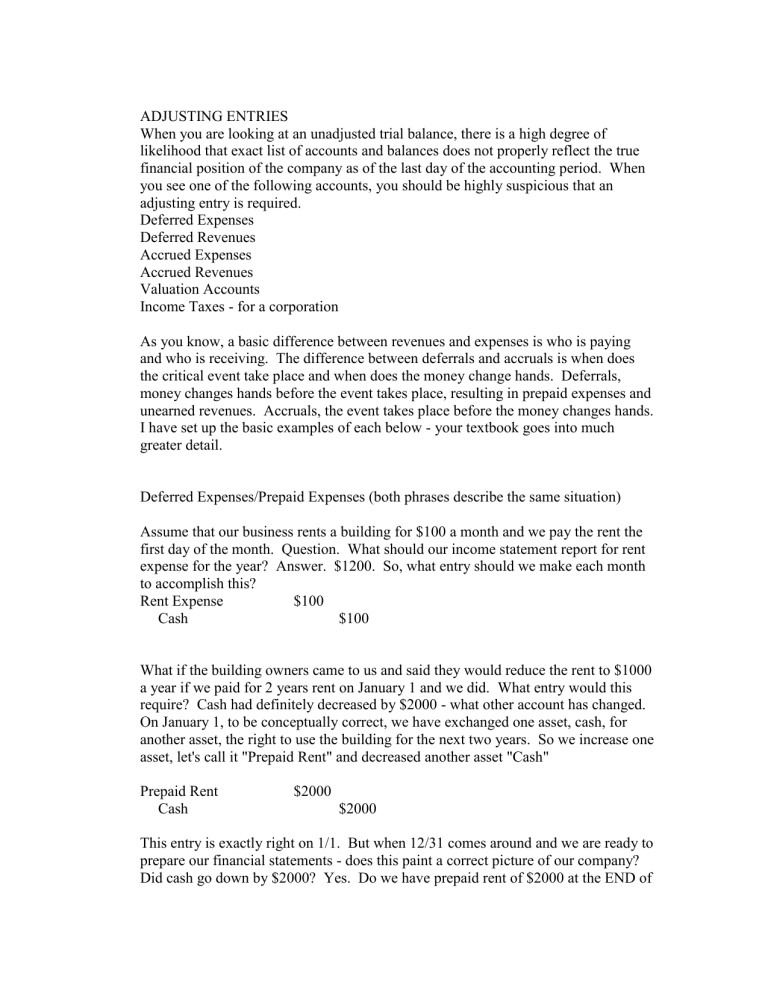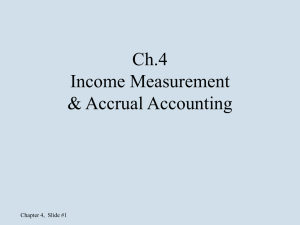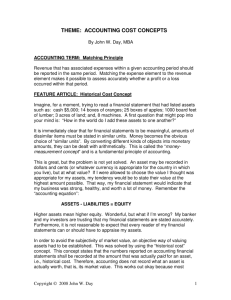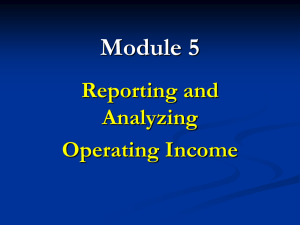ADJUSTING ENTRIES

ADJUSTING ENTRIES
When you are looking at an unadjusted trial balance, there is a high degree of likelihood that exact list of accounts and balances does not properly reflect the true financial position of the company as of the last day of the accounting period. When you see one of the following accounts, you should be highly suspicious that an adjusting entry is required.
Deferred Expenses
Deferred Revenues
Accrued Expenses
Accrued Revenues
Valuation Accounts
Income Taxes - for a corporation
As you know, a basic difference between revenues and expenses is who is paying and who is receiving. The difference between deferrals and accruals is when does the critical event take place and when does the money change hands. Deferrals, money changes hands before the event takes place, resulting in prepaid expenses and unearned revenues. Accruals, the event takes place before the money changes hands.
I have set up the basic examples of each below - your textbook goes into much greater detail.
Deferred Expenses/Prepaid Expenses (both phrases describe the same situation)
Assume that our business rents a building for $100 a month and we pay the rent the first day of the month. Question. What should our income statement report for rent expense for the year? Answer. $1200. So, what entry should we make each month to accomplish this?
Rent Expense
Cash
$100
$100
What if the building owners came to us and said they would reduce the rent to $1000 a year if we paid for 2 years rent on January 1 and we did. What entry would this require? Cash had definitely decreased by $2000 - what other account has changed.
On January 1, to be conceptually correct, we have exchanged one asset, cash, for another asset, the right to use the building for the next two years. So we increase one asset, let's call it "Prepaid Rent" and decreased another asset "Cash"
Prepaid Rent
Cash
$2000
$2000
This entry is exactly right on 1/1. But when 12/31 comes around and we are ready to prepare our financial statements - does this paint a correct picture of our company?
Did cash go down by $2000? Yes. Do we have prepaid rent of $2000 at the END of
the year? NO. We have the right to use the building (prepaid rent) for one more year. And by the way, should we report any rent expense for the year? Yes, $1000.
This example highlights the need for adjusting entries. The transaction is recorded exactly right when it occurred, but then, as a result of something (in this case- the passage of time) things change and we need to "update" the accounts to reflect the proper balance for financial statement presentation, i.e., adjusting entries.
In this case we want to decrease prepaid rent (asset) by $1000 and increase rent expense (decrease capital) by $1000.
Rent Expense
Prepaid Rent
$1000
$1000
What are the balances of the accounts?
Cash Prepaid Rent
-2000 +2000
-2000
-1000
+1000
Rent Expense
+1000
+1000
Is this right, on 12/31 did cash go down $2000 for the year? Yes. Do we have prepaid rent of $1000? Yes. Do we have rent expense of $1000? Yes. Perfect.
This is only one example for prepaid expenses, but the concept applies to anything that a company prepays.
Deferred Expenses/Deferred Revenues (again both refer to the same)
Hey, what if you were the person who OWNED the building as opposed to the guy renting above. What entries would you make? You would definitely have more assets (cash) on 1/1 but what else do you have? Any other assets change? NO. Did you earn the revenue yet? NO. So, if capital doesn't change (revenue) and no other asset changes, the only thing left is liabilities. Does this seem reasonable? YES.
Why? Because now you, as the owner of the building, you have an obligation (debt, owe, whatever) to this person to use the building for the next 2 years or you owe him back the $2000. So what entry do you make on 1/1?
Cash 2,000
Unearned Rent 2,000
Perfect on 1/1. You have an increase in cash and an increase in obligations which is exactly what your entry shows. BUT on 12/31, do you still owe the use of the building for 2 more years? NO only one more year now, AND you have earned the
revenue for the use of the building for the past years. So you need an adjustment to show the decrease in the liability and to increase revenues.
Unearned Rent 1,000
Rent Revenue 1,000
Accrued Expenses
Totally different example, lets say you hire someone on 1/1 Monday to clean your house everyday for $10 AND they end up cleaning your house everyday for the entire year. What amount should the account "house cleaning expense" have in it as of 12/31 when you prepare financial statements? Let's see, 10 buck a day, 365 days in the year, $3,650. Man, that's great. Ok. Let's see how this plays out. Let's say we pay this person every Sunday, so on Sunday, 1/ 7, the person has worked 7 days, we pay them $70, and we record the following transaction:
House cleaning expense $70
Cash $70
Perfect, we have incurred the expense, we have paid the expense, and we have recorded the expense. Absolutely perfect. And we will do the exact same thing every Sunday for the rest of the year. So let's zoom ahead. Today is Sunday, 12/29
(don't get out a calendar to see if this matches, lets just assume it does). What entry do you make? Same one.
House cleaning expense $70
Cash $70
Now it is Dec 31, time to prepare financial statements. What balance should house cleaning expense show? $3,650. How much does is show? $3,630. Why? Because the person cleaned on Monday (December 30) and Tuesday (December 31) and haven't got paid yet and therefore no entry was made. But shouldn't it have been recorded? Yes. Again, we have incurred the expense, we haven't paid it, but we still need to record it. How do we get the expense to go from 3630 to 3650? Increase it by $20. And, because we haven't paid in, on 12/31 we have an obligation (liability) to pay this $20 which also needs to be recorded.
House cleaning expense $20
House Cleaning Payable $20
Now the expense will show $3,650, cash has gone down by $3630 and liabilities have gone up by $20. Perfect. [This is a little off the subject, but what entry do you make on next Sunday?
House cleaning exp 50
House cleaning pay 20
Cash 70
Accrued Revenue
What if you were the cleaner?
Every Sunday.
Cash 70
House cleaning Revenue 70
On 12/31
House Cleaning Receivable 20
House Cleaning Revenue 20
Now your revenue would show $3,650 - exactly what it should show.
Valuation Account - Contra Asset Account - Depreciation
Assume a company buys a candle for $100 on January 1. The candle will burn exactly one year - it goes out at exactly 11:59 on December 31. What entry would you make to record its purchase?
Candle
Cash
$100
$100
This is exactly right on January 1. The company has a piece of property that it owns that will provide probable future economic benefit - i.e. an asset which is property described as candle. It has increased, and to increase an asset, debit candle. The company paid cash, an asset, which decreased. To decrease an asset, credit cash.
PERFECT. Everything is recorded as it should be on Jan 1. Time goes by and now it's December 31, time to prepare the financial statements. Do we still have an asset
(probable future economic benefit) in the form of a candle? No, it's gone, its been all used up. When we use something up to operate the business, that is an expense. So, we need to make an entry to recognize the expense and decrease the asset.
Candle Expense $100
Candle $100
So where are we? We report $100 increase in candle expense for the year and $100 decrease in cash. The candle account has cancelled itself out - dr 100 cr 100 = balance of $0.
January 1, buy a new candle for $100. We could make the same entries as above, but sooner or later we would just
Candle Expense $100
Cash $100
On Jan 1, instead of recording it originally as an asset. Why? Because it will be an expense by the time we prepare financial statements and this approach saves us from having to make the adjusting entry on Dec 31.
So, if the company repeated this for 10 years, what would be the impact on the financial statements over this time period? Each year would report $100 candle expense on the income statement and the balance sheet would report a decrease in cash of $100 along with a decrease in owners' equity of $100 to reflect the impact expenses have on owners' equity.
Hey, but what if on Jan 1, year 11, the company comes back from the candle store with a huge candle that will burn 10 years that cost $1000. What entry do you make then?
Candle
Cash
$1000
$1000
Ok, perfect. Now time goes by and its Dec 31? Does the company still have an asset (candle light for 10 years) that it had on Jan 1? No. A portion of the candle has been used up (expense) which obviously means the asset has decreased. What entry do we make? Doesn't it make sense that we would have to debit Candle Expense to recognize the candle used up and then credit Candle to show the decrease in the asset?
Candle Expense
Candle
Now the question is "for what amount"? The company paid $1000 for a 10 year asset which 1 year (or 10%) has been used up. When faced with allocation problems in accounting, we usually take what's referred to as a "systematic and rational" approach which means we basically uses common sense unless some other factor enters in that requires us to be a little more creative. In this case, if they paid $1000 for a 10 year asset, that means essentially that ($1000/10) $100 worth of the asset is used up each year - so we adjust by that amount, $100. So, for years 11 - 20, what effect does this have on the financial statements? Same as before, the income statement each year will report $100 candle expense (whether you buy 1 year or 10 year candles). Doesn't this make sense - you are using up the same asset each year so you should have the same results. As far as the balance sheet goes, the purchase of the candle just exchanged one asset, cash, for another asset, candle - which has a net effect of zero. Then each year, the asset candle decreases by $100 and owners equity has a corresponding decrease ($100) to reflect the impact the expense has on owners equity.
Ok, think about that stuff for awhile.
Now think about this, let's talk about a car instead of a candle. When I tell you that a company has $100 car expense on the income statement, what comes to your mind?
I'm thinking tune ups, gas, and some type of an expense I have associated with the car. And another thing, when I decrease the record (account) I have been keeping for the car, what comes to your mind? I'm thinking you got rid of a car.
Let's remove the possibility of confusion. When we are making an adjusting entry to reflect the using up of a plant asset (car, building, equipment, etc), let's preface the account with the word depreciation so I can understand the difference between cost allocation and new expenditures. And, since the car (or at least 1/10th of it) has not actually disappeared, let's make sure that we identify that we are recording a decrease in the asset because we think we are using it up as opposed to it actually being gone. This approach would give us the following adjusting entry.
Deprecation Expense - Car
Accumulated Deprecation - Car
$100
$100
What kind of account is Accumulated Deprecation? It is a valuation account which means it is always thought of in conjuncture with some other account (in this case car) to disclose the appropriate value on the balance sheet for the item. When valuation accounts are added to the "other" account, it is referred to as an adjunct account. When the valuation account is subtracted from the "other account", it is referred to as a contra account. [This means that if both accounts have debit or credit balances, then it is an adjunct account. If one account has a debit balance and the other a credit - these offset each other and we have a contra account.] So, where are we are with our entry?
The income statement will show $100 expense each year (has it always has, just calling it depreciation expense now). The balance sheet each year will show a decrease in owner equity each year as a result of the expense (as it always has) and the assets will decrease $100 each years as always except it is now accomplished through the use of the contra account (or you may want to think of it as a negative asset - but that is not sound conceptually) accumulated deprecation.
So, what do you think? Here we have the double whammy of having to conceptualize either [1] the using up of a prepaid item (prepaid rent example), [2] the earning of unearned rent, and [3] the using up of a plant asset; BUT also, keeping in mind the effects these adjustments have and the application of the rules of debits and credits to get it recorded. This is why we have spent so much time this semester focusing on these first chapters in that if we do not have a basic understanding of how to record transactions (both external and adjusting) then the later chapters looking at other types of transactions aren't as easy to comprehend. But, you will notice if you flip thru your textbook, you will see that entire chapters coming up are devoted to accounts receivable and the related adjusting entries, and the same for
depreciation, inventory, etc. So keeping studying the chapters and really try to understand the examples that are given.







